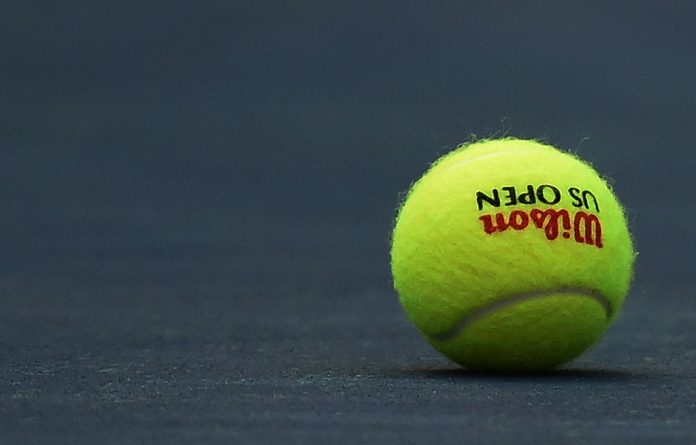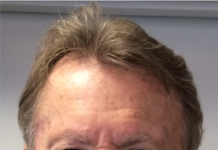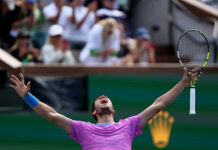Bill Simons
They say the US Open is open – right? But even though New York has flattened its COVID-19 curve, the pandemic is spiking all over the place. Uncertainty again hovers.
So Inside Tennis decided to talk with Michael Dowse, the dynamic, relatively new Executive Director of the USTA who turned out to be a bit of a miracle worker. Despite all, he spearheaded the effort to make the 2020 US Open happen without triggering tennis’ sometimes demanding and irritable stakeholders and critics.
*****
INSIDE TENNIS: A few weeks ago, you announced that the Open was going forward – what a relief. At long last there were some good vibes – people felt great. Then, all of a sudden, images emerged of the Adria Tour in the Balkans. Players and their pals were embracing and dancing in discos. Grigor Dimitrov, Djokovic and many others tested positive. What went through your mind?
MICHAEL DOWSE: I wanted them to be healthy – that’s what’s most important for everyone. As for us, there were always three principles we established to have the Open: everyone’s health, the good of the game and the financials. And those are still true today.
If we can’t meet those three principles, then we can’t host the tournament. As of today, we still can. New York has given us the approval and blessing with our health protocols. You know that could change, but as of today it’s still favorable. And with that, we got commitments from great players [including Serena] and we knew we could make the Open work financially. So those three principles are still a go.
But it is fluid, right? We don’t want to put people or players at risk. Someone may test positive – that’s mathematically a highly likely scenario – but there’s a difference between someone testing positive and then contributing to an outbreak.
Do you have a sense in your gut that the Open will be definitely happening, maybe happening, or…
It’s speculation right now. We know what we know today, and today is a green light. But again, somewhere along the line if we can’t check the box for one of our three principles we won’t do it. We love tennis and we wake up every day to grow and promote it. But we also would never put it ahead of the health and safety of anyone, and that means people in New York, players and staff. We know our role.
We all know that pro Frances Tiafoe is such a dynamic, charismatic young force – so full of life. Now he’s tested positive. Is that just a single incident or does that get you thinking?
As far as I know it’s a single incident. That’s just the nature of our society right now – people are testing positive. Whether it had any relation to the tournament [in Atlanta] it’s tough to say.
World TeamTennis announced Tiafoe won’t be playing when their season starts on July 12. Is it a plus to have the World TeamTennis season in West Virginia so you can see what happens?
There are various events going on and we want to see tennis being played. That’s a good thing. I don’t know how World Team Tennis compares to our situation. How we are going to run the Open and our protocols are substantially different.
Everyone knows the US Open’s brand is New York intense. Sometimes it’s messy and boisterous. Above all else, it’s loud – a wall of sound descends. This year the two players will be virtually alone in the vast Ashe Arena. What do you think?
Our team is putting together a whole bunch of different options and sharing it with our media partners and ultimately with the players. Do they want crowd noise to be fed in? Do they want virtual fans projected on LED boards and do we turn those off during points? Will that be distracting? Those are the things we’re testing now. The flip side is that an Open without fans on site gives you an opportunity to do things that haven’t been done before. There will be a lot more behind-the-scenes content for people to watch. There’ll be interviews and cameras in different places we haven’t had before. They will be in entry tunnels, lounges and spaces dedicated to the players.
Is there any chance there will be a shift on the media situation? Now there will be virtually no media on site. It’s tough for us writers. We all know it’s a new world, but is there any chance that that could be loosened up?
Chris Widmaier [the USTA’s Director of Corporate Communications] is running point on that. If we get clearance to add more people on site that’s something we’d entertain. The health of everyone has a higher chance the smaller number of people we have.
Health concerns, of course, come first. Still, it would be great to have more of the media on hand to tell the Open’s story. But if it can’t happen, it can’t happen. Anyway, on their off days, will players sequester off site?
Right. We’ve got three hotels. The TWA Hotel is for players. Each one is allocated two rooms. So if players want a coach and physio to share a room they can have two people with them and their partner as well. We will have two other hotels outside of Manhattan for the staff and others supporting the Open.
I’m sure the Open has been important to you. Do you have a special US Open moment that touched you?
Probably around 1993, when I was an entry level person with Wilson. It was the first year we sold jumbo balls. It was out of a little plywood gap in Louis Armstrong Stadium. Now, you look at the US Open and it just gives you such an appreciation of how cool the tournament is.
The Open is such a big happening, but for some it’s also an easy target of criticism. Just what is its role in American tennis, whether in Omaha, Nebraska or Waco, Texas?
It is the megaphone for tennis. It’s a platform for tennis. It’s the grand stage of tennis. And it creates. I always like the word “tell-ability.” That’s when you win with consumers, when someone goes home at night to their family or loved ones and talks about all the great points or great moments at the Open, whether they watched on TV or in person. The Open creates moments of tell-ability for our sport.
Was Jimmy Connors’ run back in ‘91 important in establishing the Open?
I vividly remember asking, “How crazy is this?” I was watching it on TV in a restaurant or bar and there was Jimmy with his bright yellow Estusa racket.
No other tournament has scratched or fought for its life like the 2020 Open. What was the single biggest challenge?
Our health protocol was so detailed and professional that now we can run it as safely as possible. We have some great advisors, like the NCAA’s Dr. Brian Hainline and Mt. Sinai’s Dr. Bernard Camins, who are true experts. After all, the Open is such an iconic moment in sports.



















